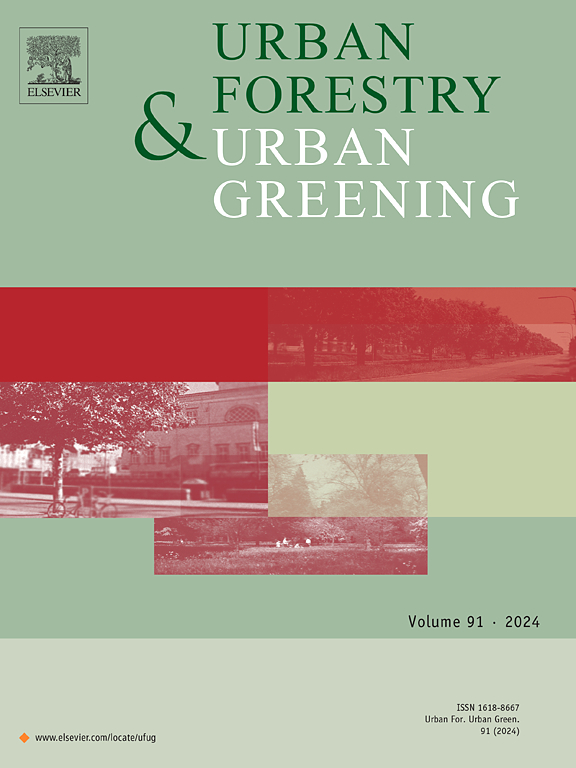栖息地破碎化对城市绿地繁殖和越冬鸟类群落稳定性的影响对比
IF 6
2区 环境科学与生态学
Q1 ENVIRONMENTAL STUDIES
引用次数: 0
摘要
随着全球城市化进程的加快,绿地成为城市环境中生物多样性保护的重要避难所,其维持野生动物群落稳定的有效性受到了威胁。虽然许多研究已经探讨了自然景观中栖息地破碎化对群落稳定性的影响,但栖息地破碎化和物种特征如何影响城市绿地中野生动物群落的稳定性仍然是未知的。在这里,我们调查了中国上海沿城市化梯度的19个绿地的鸟类群落,历时5年。在我们的研究中,栖息地破碎化的特征是高度城市化地区特定城市绿地的高边缘密度和高斑块隔离。我们以群落总丰度的时间不变性来衡量群落稳定性,并将其划分为种群不同步和种群稳定。因此,我们探讨了栖息地破碎化和物种特征(以功能多样性衡量)对城市鸟类群落稳定性的影响。鸟类功能多样性通过种群在繁殖期和冬季的稳定性降低了群落的稳定性。生境破碎化通过功能多样性间接提高了群落稳定性。此外,栖息地破碎化仅在繁殖季节导致种群不同步,从而降低了鸟类群落的稳定性。研究结果表明,城市功能多样性与社区稳定性之间存在负相关关系。此外,生境破碎化的季节效应对比表明,城市绿地规划策略应具有季节适应性。在繁殖季节,连接破碎的栖息地对于支持功能多样性和稳定性至关重要,而在冬季保持一定程度的破碎化可能有助于稳定群落。本文章由计算机程序翻译,如有差异,请以英文原文为准。
Contrasting effects of habitat fragmentation on community stability of breeding and wintering birds in urban green spaces
Green spaces are crucial refuges for biodiversity conservation in urban environments with the accelerating rate of urbanization worldwide, which threatens their effectiveness in maintaining stable wildlife communities. While many studies have examined the effects of habitat fragmentation on community stability in natural landscapes, it is still unknown how habitat fragmentation and species traits shape wildlife community stability in urban green spaces. Here, we surveyed bird communities over five years in 19 green spaces along an urbanization gradient in Shanghai, China. In our study, habitat fragmentation was characterized by high edge density and high patch isolation of a particular urban green space in a highly urbanized area. We measured community stability as the temporal invariability of the total community abundance and partitioned it into population asynchrony and population stability. We thus explored how habitat fragmentation and species traits (measured as functional diversity) affect the community stability of urban birds. We found that bird functional diversity reduced community stability through population stability in the breeding and winter seasons. Habitat fragmentation increased community stability indirectly through functional diversity in both seasons. Furthermore, habitat fragmentation decreased the stability of bird communities through population asynchrony only in the breeding season. Our findings demonstrate the negative relationships between functional diversity and community stability in urban areas. Moreover, the contrasting seasonal effects of habitat fragmentation suggest that urban green space planning strategies should be seasonally adaptive. Connecting fragmented habitats is essential in the breeding season to support functional diversity and stability, while maintaining a certain level of fragmentation in winter may help stabilize communities.
求助全文
通过发布文献求助,成功后即可免费获取论文全文。
去求助
来源期刊

Urban Forestry & Urban Greening
FORESTRY-
CiteScore
11.70
自引率
12.50%
发文量
289
审稿时长
70 days
期刊介绍:
Urban Forestry and Urban Greening is a refereed, international journal aimed at presenting high-quality research with urban and peri-urban woody and non-woody vegetation and its use, planning, design, establishment and management as its main topics. Urban Forestry and Urban Greening concentrates on all tree-dominated (as joint together in the urban forest) as well as other green resources in and around urban areas, such as woodlands, public and private urban parks and gardens, urban nature areas, street tree and square plantations, botanical gardens and cemeteries.
The journal welcomes basic and applied research papers, as well as review papers and short communications. Contributions should focus on one or more of the following aspects:
-Form and functions of urban forests and other vegetation, including aspects of urban ecology.
-Policy-making, planning and design related to urban forests and other vegetation.
-Selection and establishment of tree resources and other vegetation for urban environments.
-Management of urban forests and other vegetation.
Original contributions of a high academic standard are invited from a wide range of disciplines and fields, including forestry, biology, horticulture, arboriculture, landscape ecology, pathology, soil science, hydrology, landscape architecture, landscape planning, urban planning and design, economics, sociology, environmental psychology, public health, and education.
 求助内容:
求助内容: 应助结果提醒方式:
应助结果提醒方式:


